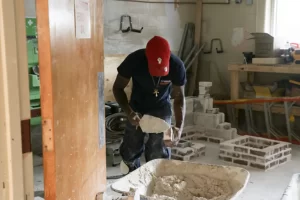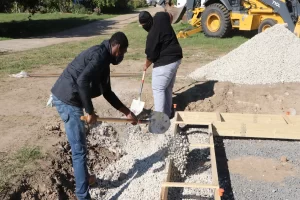The type of construction taught in trade schools for construction is influenced by the materials used and the structure’s design, which affect a building’s ability to withstand fire, earthquakes, and other related events. This comprises all the building’s structural elements and non-load-bearing parts. There are five major construction types as students in trade schools for construction are taught about.
Most of the buildings initially have similar structures. But a building’s durability is chiefly influenced by its foundational elements. Our project classification system ranges from Type 1 to Type 5, primarily based on how fire-resistant construction is. While some facilities are more critical and less expensive, they have poor fire resistance. The best and worst fire resistors are found in category 1 and type 5 constructions.
Type 1 structures are typically for high-rise residences and businesses. These structures are the most fire-resistant because they are primarily built of concrete and steel. They are capable of withstanding high temperatures for an extended period. These ratings apply to roof and floor assemblies, internal partitions, and bearing and support walls.
They are not susceptible to collapsing and can withstand fire for up to four hours, which is one of these structures’ strengths. However, if the structures are steel, corrosion causes them to rust with time, which is a weakness. These buildings’ roofs and windows are also difficult to break through during a fire. There are pressurized stairwells in some of these buildings to prevent the spread of fire.
Most contemporary “big box” retailers and shopping centers fall within the Type 2 building category. These structures generally contain non-combustible materials, including lightweight concrete, metals, and masonry. But flammable substances like rubber and foam can be present. Despite having effective fire suppression systems, these structures are vulnerable to collapse, primarily due to the many types of roofs atop them.
Firefighters work to ventilate the building after a fire to prevent flashovers and sudden increases in temperature. As taught in construction training near you, these structures burn for one to two hours, depending on the construction materials utilized. Slow-burning construction materials contribute to the fire’s growth. Firefighters use roll-up doors or skylights to a building’s outside to ventilate these structures during a fire.
Type 1 and type 2 structures differ significantly from one another. In the event of a fire, type two buildings are vulnerable, almost completely collapsing the structure. The interior partitions of these buildings are constructed primarily out of non-combustible materials, with a few permitted combustible materials. Modern schools are a prime example of various sorts of construction.
The term “brick and joint structures” is also used to describe these architectural frameworks. Brick or masonry-built walls, a wooden roof, and fire-resistant floors are all features of these buildings, as taught for construction jobs. Most frequently, flammable materials are used for all or a portion of the interior components, including the frames, floors, and ceilings. The roofs of all type three structures are made of wood. However, newer structures have lightweight roofing systems, while older ones typically have framed roofs.
Both reinforced masonry and concrete are used for the walls. Before making crucial ventilation choices, firefighters must decide whether a type 3 building is new or ancient. The construction type category for traditional buildings includes both new and historic structures. Schools, homes, and small businesses are among the structures in this group.
These structures benefit from remaining standing even if floors fall, thanks to their unique material combinations. Their primary flaw is that the spread of fire is made possible by the numerous connected attics or vacant spaces.

The majority of structures built before 1960 were of the heavy timber variety. They have timber walls and roof spans, making them simple for firemen to identify. The timber members might be solid or laminated and must meet certain dimensional specifications. Old industries, churches, barns, and residential homes are a few examples of this structure. The minimum thickness for these kinds of buildings for structural supports such as beams, arches, and columns is eight inches. These are helpful in construction apprenticeship programs.
The load-bearing walls of these structures may occasionally be non-combustible. Additionally, because they quickly remove water, firefighters may easily put out fires with less difficulty and without adding to the structure’s weight. Most connections are made using metal joint connectors, prone to failure during fires. Oil, merchandise, and other items can cause fires in industries worse. Even though termite decay and weather damage increase the risk of collapse, large dimensional timber buildings stand up well in fires.
Type 5 construction is used in a lot of brand-new, contemporary homes. Considering that the walls and roof are made of combustible materials. These construction training are made out of lightweight or combustible manufactured wood instead of the vast dimension of wood used in heavy timber-type buildings. This building’s components are reasonably priced, simple to assemble, and sturdy. But if there’s a fire, it isn’t fire-resistant and falls in minutes.
But because of the wood frames, which provide good ventilation, firefighters can handle these structures. However, due to the excellent airflow, this is also a drawback because the fire spreads quickly. Using large timber members as the primary structural elements can reduce the risk of these buildings collapsing. It also fortifies internal platforms and avoids collapse. However, these buildings lack adequate fire resistance characteristics overall.

Knowing a structure’s construction type is essential for firefighters and building users. Firefighters can immediately plan their course of action if they can determine the type of construction training programs. Making important decisions regarding ventilation and water is aided by understanding how fire spreads. Thus, a thorough understanding of different construction types contributes to lifesaving.
The construction also influences the durability of a structure against unforeseeable disasters like hurricanes and earthquakes. Therefore, construction personnel need to be mindful of how their job may affect the building’s future safety.
Read More